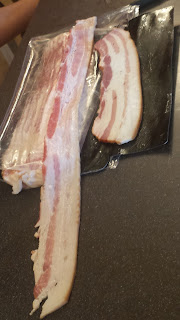Every Sunday morning was scrambled egg day when I was growing up. We had pancakes or the like on Saturdays and the rest of the week I think we must have just had cereal. After a Farm Bureau trip my parent took to Washington, D.C., my mom came home and was telling us about the most delicious breakfast they had - scrambled eggs with vegetables in them! Mushroom, peppers, onions with scrambled eggs - what an innovation! We loved them and maybe that was the beginning of my leap into "exotic foods", and maybe the start of my preference for eggs with "stuff".
This led to a discussion about how food has evolved over time. We had watched a series on History Channel about the Foods that Built America last year and learned about the beginning of ketchup. It started as a way to cover up the rancid taste of meat! In the 150+ years since ketchup was released, we have become a a society that has moved from hoping our food won't kill us to being completely food-centric. Everyone is looking for the newest hack, mash-up (fusion, to be fancy) or international oddity to make their recipes, blogs or TV shows stand out from all the rest. At the same time, ironically, there is a rise in meal services to help streamline meal preparation and to even remove the step of going to the grocery store.

Enter into our conversation Kitchen-Klatter. Raise your hand if you are familiar with Kitchen-Klatter. Anyone?
My grandma was a Kitchen-Klatter "groupie". It started as a radio show in the 1920's where the host, Leanna Driftmier, shared her recipes and household tips from Shenandoah, Iowa to mid-western kitchens in five states. I asked my mom if she remembers listening to the radio show and she said that she and her siblings were required to be quiet while Grandma listened to it every day. It served as a connection point between isolated rural housewives, a "friend" of sorts. The program branched out to cookbooks, magazines, newsletters and even their own line of flavorings and more. My mom said she still has a box full of the flavorings that my grandmother had purchased. The rise in the variety of "convenience" products such as condensed soups, Jell-O, instant puddings and Minute Rice was definitely a driving force behind the recipes.
 I pulled out my dilapidated copy and started flipping through the crumpled pages. It was truly a time capsule, a reflection of a different time in our world. I realized that over time I have only really explored the baked goods pages and there are several recipes that I use all the time, like the Excellent Pumpkin Bread recipe I'm going to share. As I worked through the meat and casserole section, I couldn't help but laugh at the recipes that contain loads of noodles, canned soups, vegetables and meats, instant rice and a thorough lack of herbs. I mentioned that to my mom and she shared that herbs were not part of their food life on the farm. Then there was the salad section. I couldn't handle most of the recipes, many of which contain gelatin flavors that aren't even a thing anymore. My favorite was something called a Mustard Ring, described as Extra Special. It's gelatin. And mustard. In a ring. That IS special. I also loved when they included a pronunciation guide for the word Quiche (keesh).
I pulled out my dilapidated copy and started flipping through the crumpled pages. It was truly a time capsule, a reflection of a different time in our world. I realized that over time I have only really explored the baked goods pages and there are several recipes that I use all the time, like the Excellent Pumpkin Bread recipe I'm going to share. As I worked through the meat and casserole section, I couldn't help but laugh at the recipes that contain loads of noodles, canned soups, vegetables and meats, instant rice and a thorough lack of herbs. I mentioned that to my mom and she shared that herbs were not part of their food life on the farm. Then there was the salad section. I couldn't handle most of the recipes, many of which contain gelatin flavors that aren't even a thing anymore. My favorite was something called a Mustard Ring, described as Extra Special. It's gelatin. And mustard. In a ring. That IS special. I also loved when they included a pronunciation guide for the word Quiche (keesh).  While a lot of the recipes are not my cup of tea, the baked goods are fabulous! My all-time favorite chocolate frosting is in this cookbook, along with it being the source of my biscuit and waffle recipes. One recipe I remember making as a young baker was the pumpkin bread recipe. It is as billed - Excellent Pumpkin Bread. It's easy to make and does not involve gelatin or canned soup. Thankfully. It did call for a few of their flavorings that I don't have, so I subbed out with vanilla and the zest of an orange. I made it into muffins instead of the bread and only made half a recipe and added an easy streusel to part of them. I was disappointed to be out of walnuts, because those are my favorite nuts for this bread. Actually, my favorite are the black walnuts off my grandma's tree, but that's a whole other story.
While a lot of the recipes are not my cup of tea, the baked goods are fabulous! My all-time favorite chocolate frosting is in this cookbook, along with it being the source of my biscuit and waffle recipes. One recipe I remember making as a young baker was the pumpkin bread recipe. It is as billed - Excellent Pumpkin Bread. It's easy to make and does not involve gelatin or canned soup. Thankfully. It did call for a few of their flavorings that I don't have, so I subbed out with vanilla and the zest of an orange. I made it into muffins instead of the bread and only made half a recipe and added an easy streusel to part of them. I was disappointed to be out of walnuts, because those are my favorite nuts for this bread. Actually, my favorite are the black walnuts off my grandma's tree, but that's a whole other story.In the midst of all the crazy food trends, sometimes getting back to the basics isn't a bad thing. Now, if you'll excuse me, I need a cup of coffee, some Louis Armstrong and one of my classic pumpkin muffins.
To make the streusel, mix 1/4 cup flour, 1/4 cup brown sugar, a pinch of salt and 1/2-1 tsp. pumpkin pie spice in a bowl. Add 1/4 cup chopped nuts if you like. Melt 2 T. butter and stir in to dry ingredients. Top muffins or bread with the streusel. This makes enough streusel for 18 muffins. Also, as a side note, I baked the muffins for 15-20 minutes.




























